Watching Green Soldier Flies in the Garden
I spent a fair amount of time last Summer watching the insects on our garden flowers. Some of my favorite insects were the Green Soldier Flies (Hedriodiscus sp). These flies were active for much of the Summer - from at least mid-June through late August.
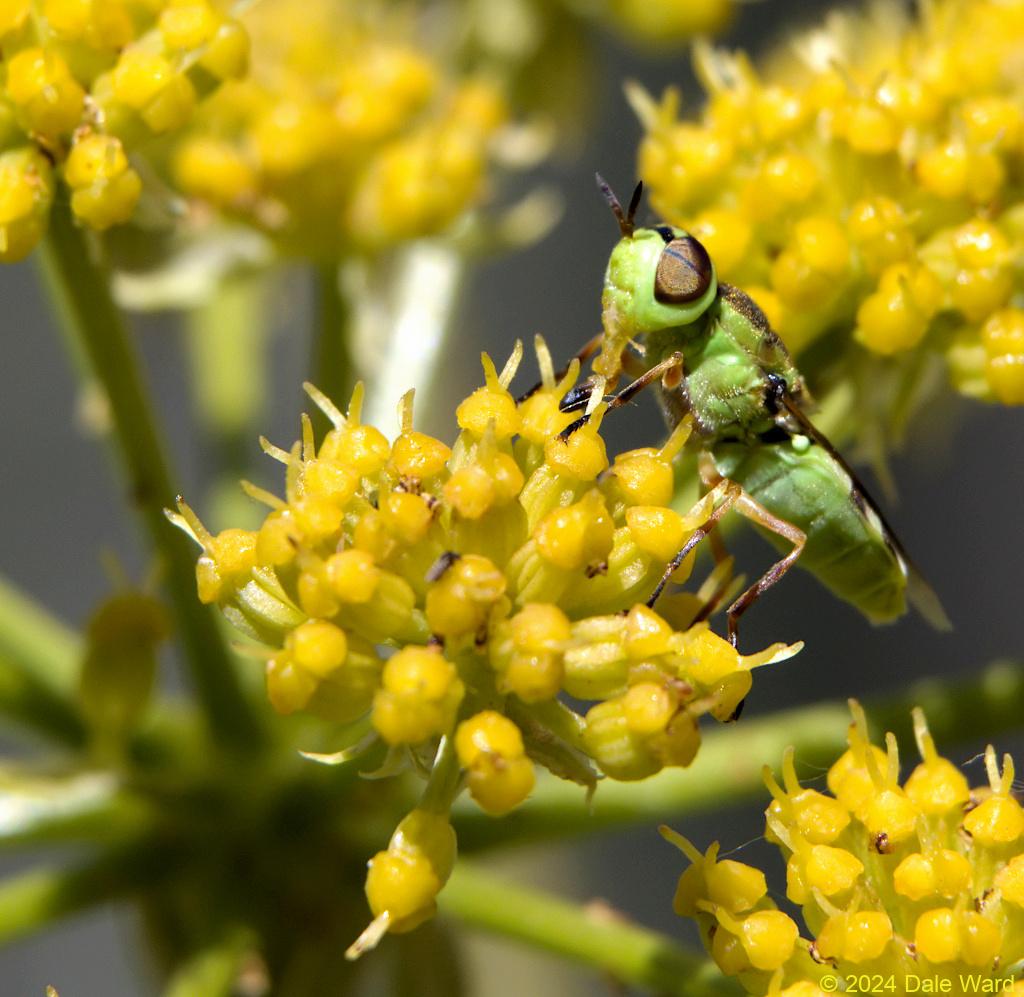 Green Soldier Fly (_Hedriodiscus sp._) drinking nectar from Parsley flowers
Green Soldier Fly (_Hedriodiscus sp._) drinking nectar from Parsley flowers
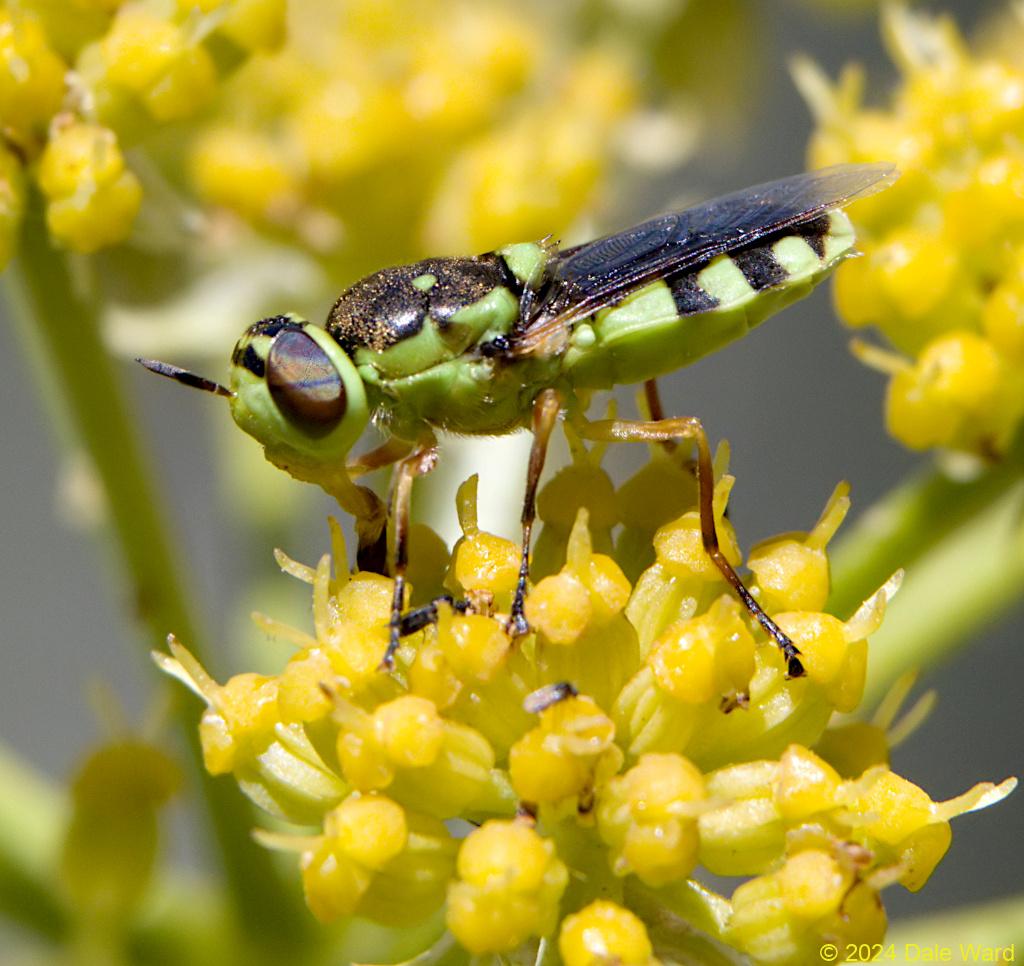 Side view of a Green Soldier Fly (_Hedriodiscus sp_.) on a parsley flower.
Side view of a Green Soldier Fly (_Hedriodiscus sp_.) on a parsley flower.
They were perhaps a centimeter long, large enough to see easily. They spent most of their time perched on the wild onion and the parsley flowers. This may seem like a strange thing to say, but these were stunningly beautiful flies, colored lime-green with brown or black strips and blotches on them.
Here in Southwestern Colorado, at about 6200 elevation’, seeing such tropical-appearing insects was quite a treat.
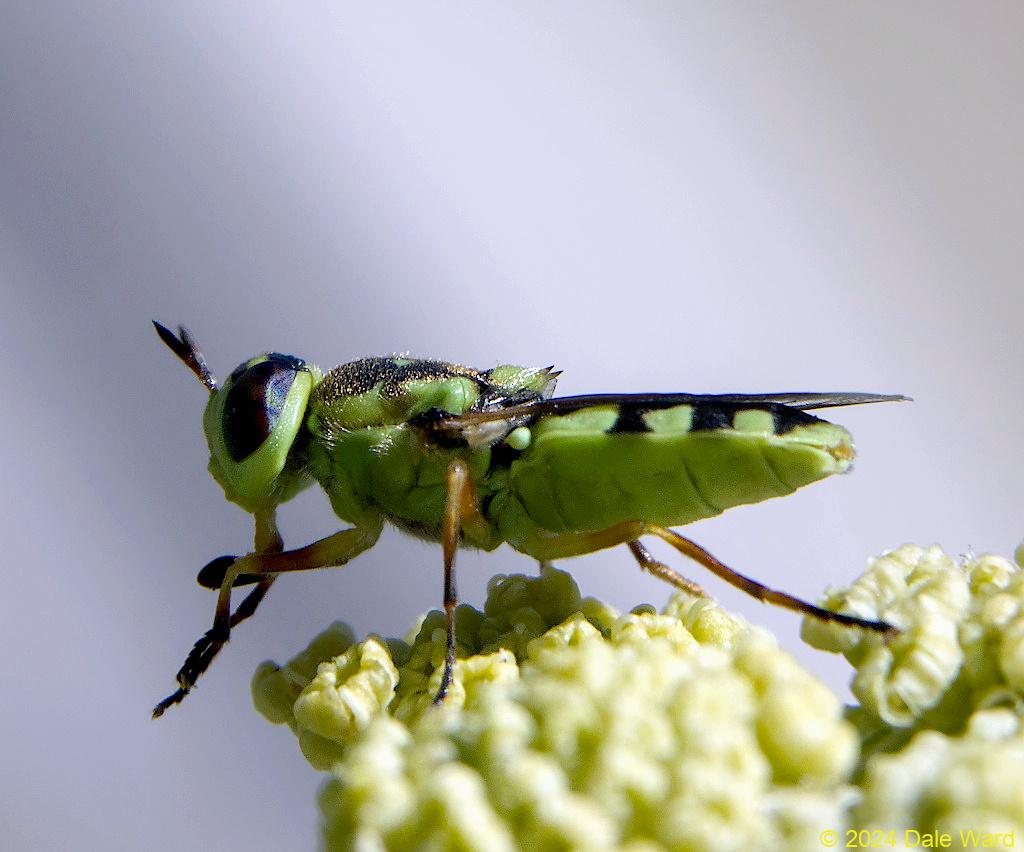 Side view of Green Soldier Fly (_Hedriodiscus sp_), showing spines on the thorax.
Side view of Green Soldier Fly (_Hedriodiscus sp_), showing spines on the thorax.
Some, but not all, of the Green Soldier Flies had tiny spines on their thorax, as in the photo above. Others had very attenuated, weak spines, and still others had no obvious spines at all.
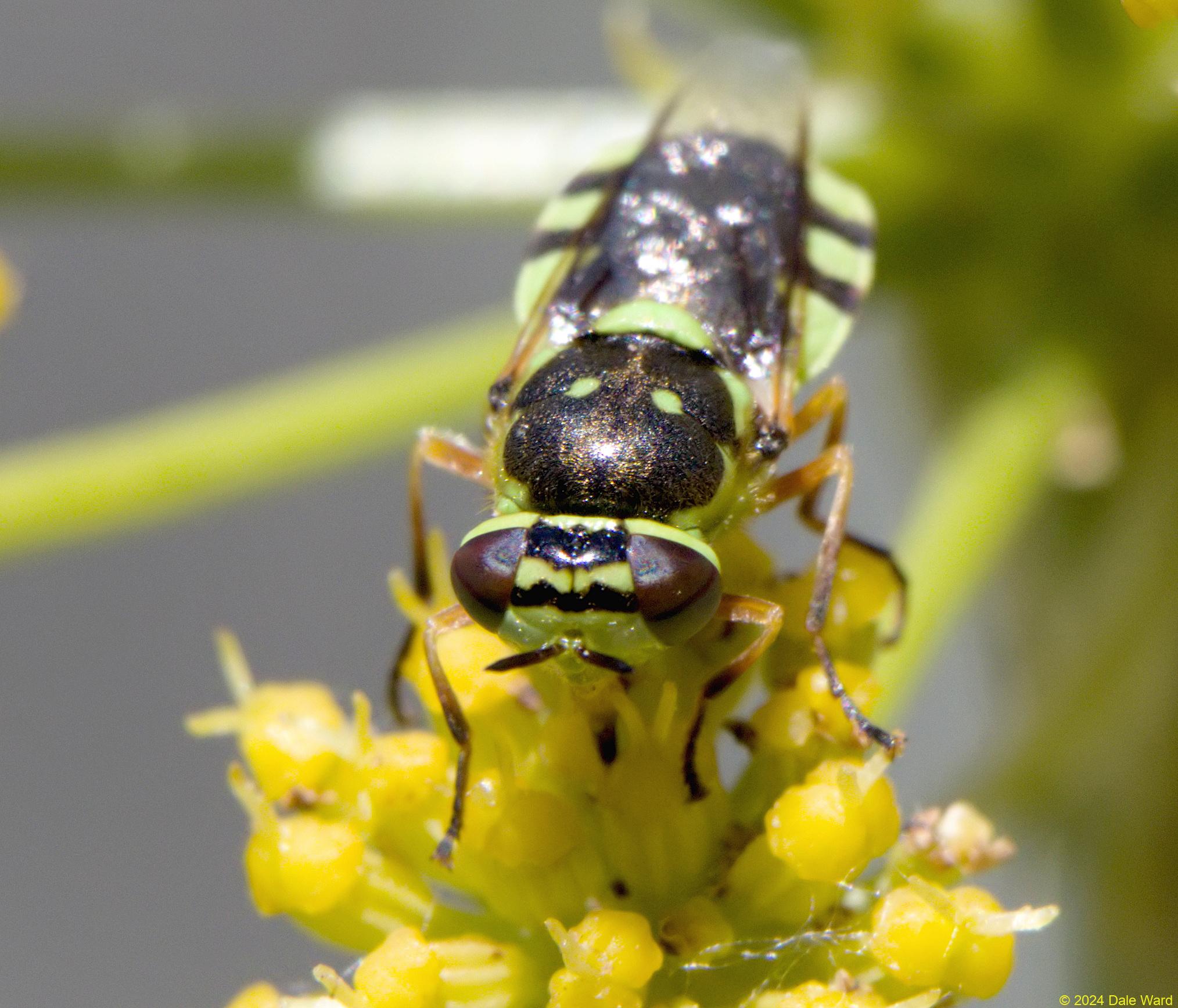 Front view of a Green Soldier Fly (_Hedriodiscus sp._) on a parsley flower.
Front view of a Green Soldier Fly (_Hedriodiscus sp._) on a parsley flower.
The flies didn’t all have the exact same color patterning on their bodies, either. You may notice that some of the flies in these photos have a pair of green dots on the thorax, making a pattern which reminded me of a stylized eye sockets on a skull. Others didn’t have these green dots, instead having a solid-black thorax.
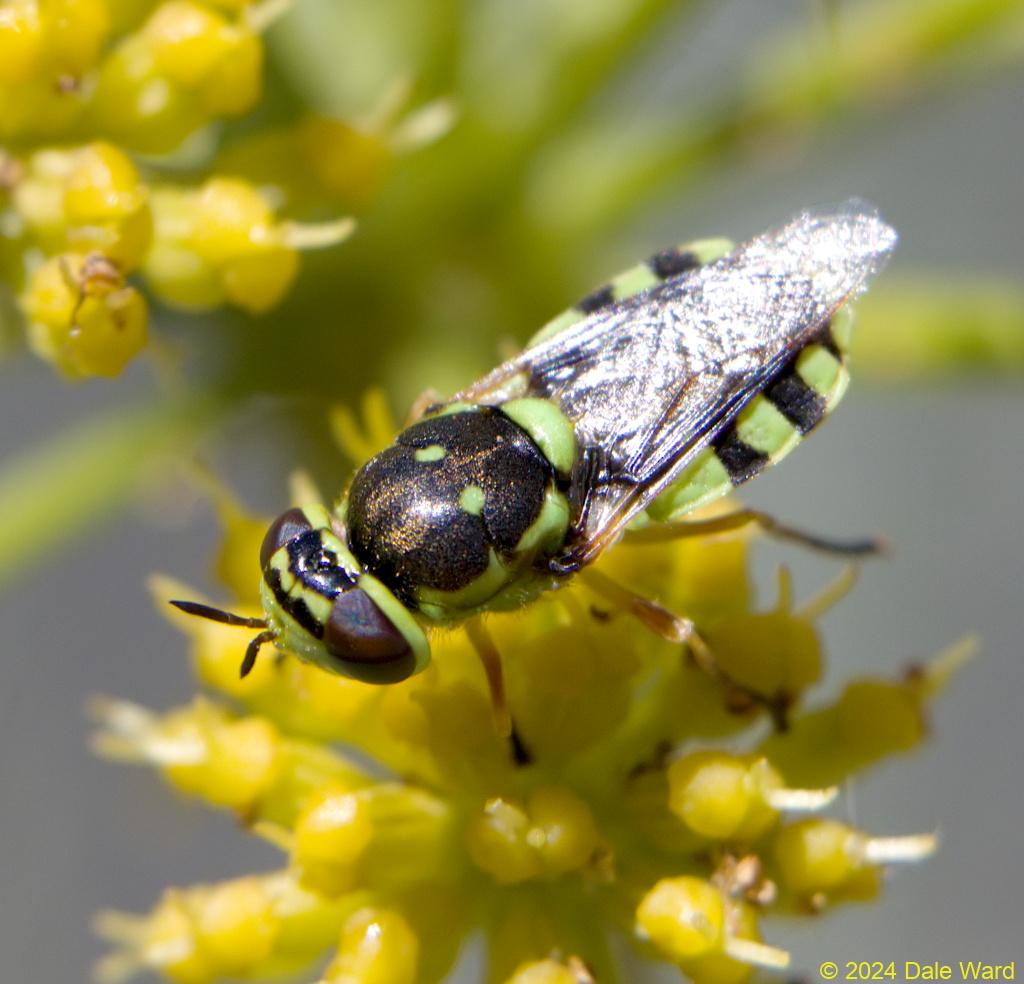 Green Soldier Fly (_Hedriodiscus sp_) on parsley flower. They had flattened abdomens that project out laterally, much wider than their wings. This made the green of their abdomens really visible.
Green Soldier Fly (_Hedriodiscus sp_) on parsley flower. They had flattened abdomens that project out laterally, much wider than their wings. This made the green of their abdomens really visible.
Watching the Green Soldier Flies on the Wild Onion flowers was especially fascinating. The flowers exude nectar near the base of their petals, around the style of the flower. The flies would push into to the center of the flowers and to get at the nectar, as in the photo below.
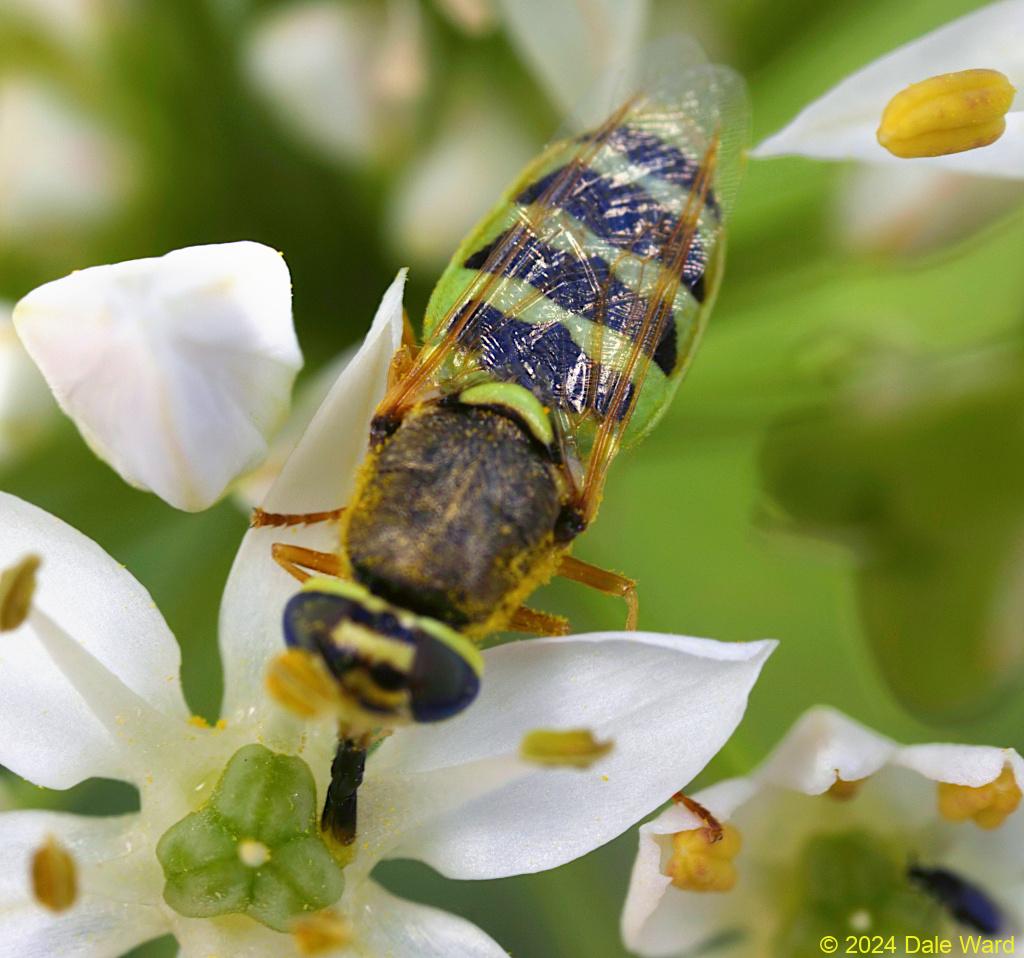 Green Solider Fly drinking nectar from a Wild Onion Flower. The fly has its tongue extended and is drinking nectar.
Green Solider Fly drinking nectar from a Wild Onion Flower. The fly has its tongue extended and is drinking nectar.
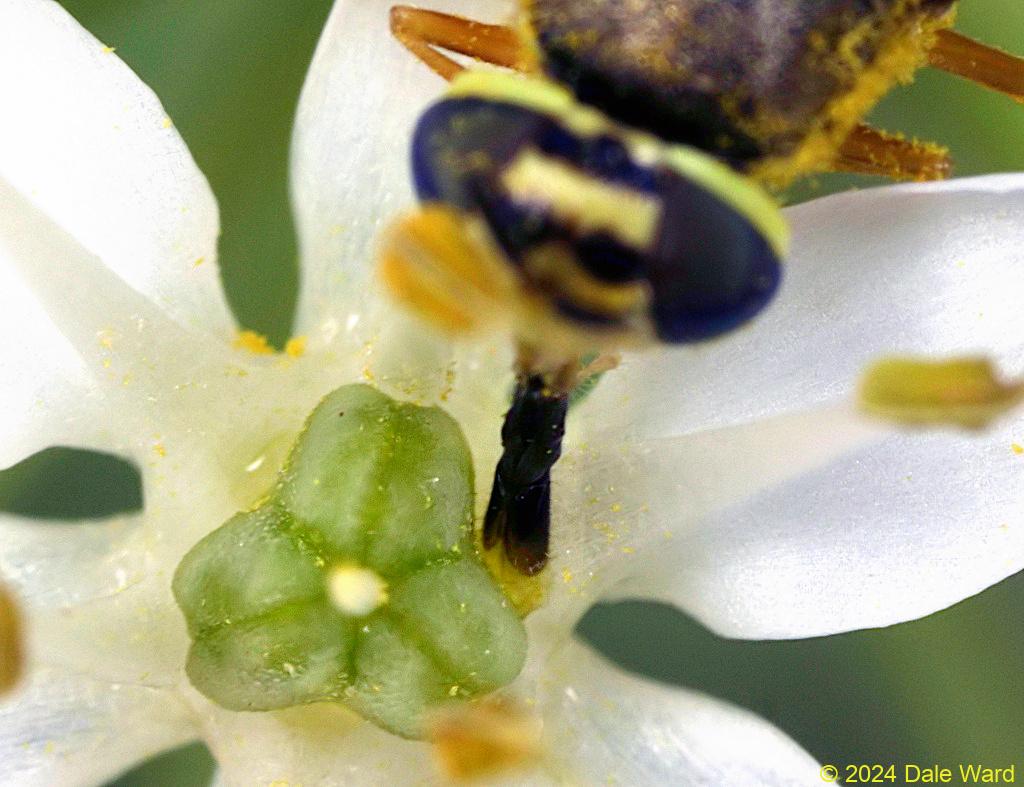 Closer view of a Green Solider Fly drinking nectar from a Wild Onion Flower. The fly has its tongue extended and is drinking nectar.
Closer view of a Green Solider Fly drinking nectar from a Wild Onion Flower. The fly has its tongue extended and is drinking nectar.
To get close enough to the nectar, the flies would push their heads and thoraxes in between the pollen-laden stamens, the male parts of the flower. As the flies shouldered their way in, the stamens would act like dust-covered paint brushes, smearing the flies with pollen grains.
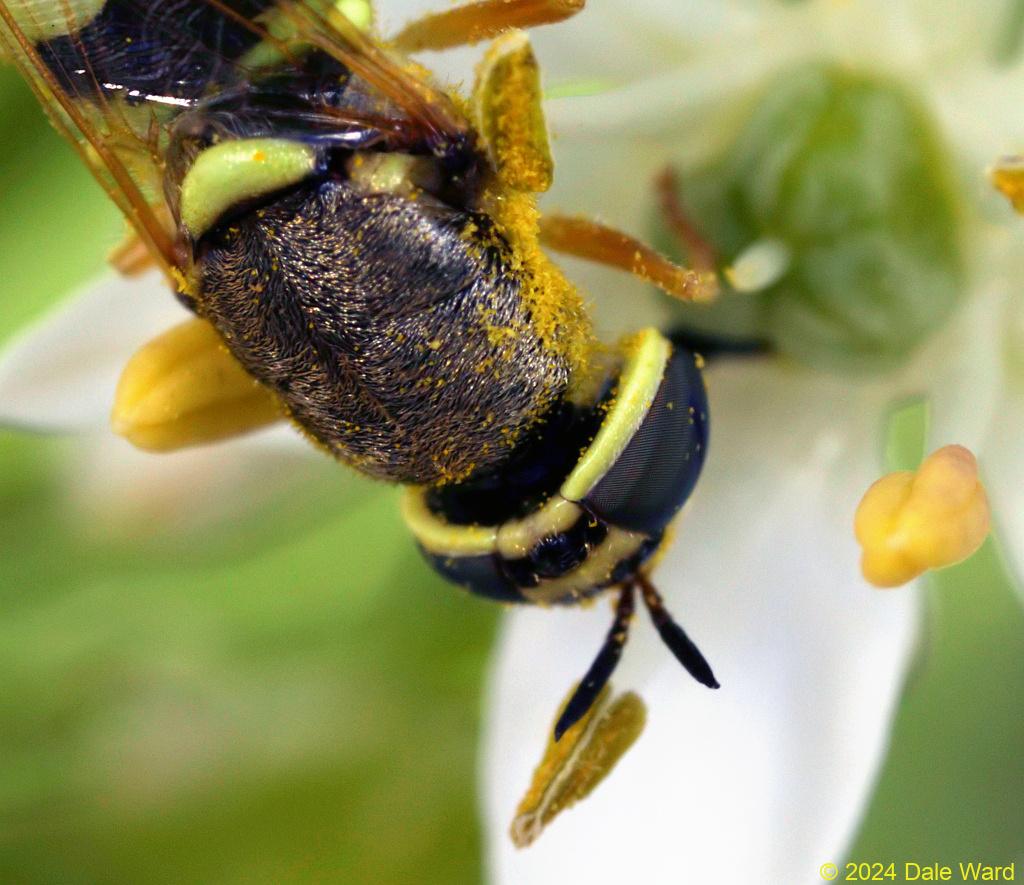 Closer view of a Green Soldier Fly (_Hedriodiscus sp_) drinking nectar from a Wild Onion flower. The fly is putting its body between two of the flower’s stamens, and some of their pollen is sticking to the fly.
Closer view of a Green Soldier Fly (_Hedriodiscus sp_) drinking nectar from a Wild Onion flower. The fly is putting its body between two of the flower’s stamens, and some of their pollen is sticking to the fly.
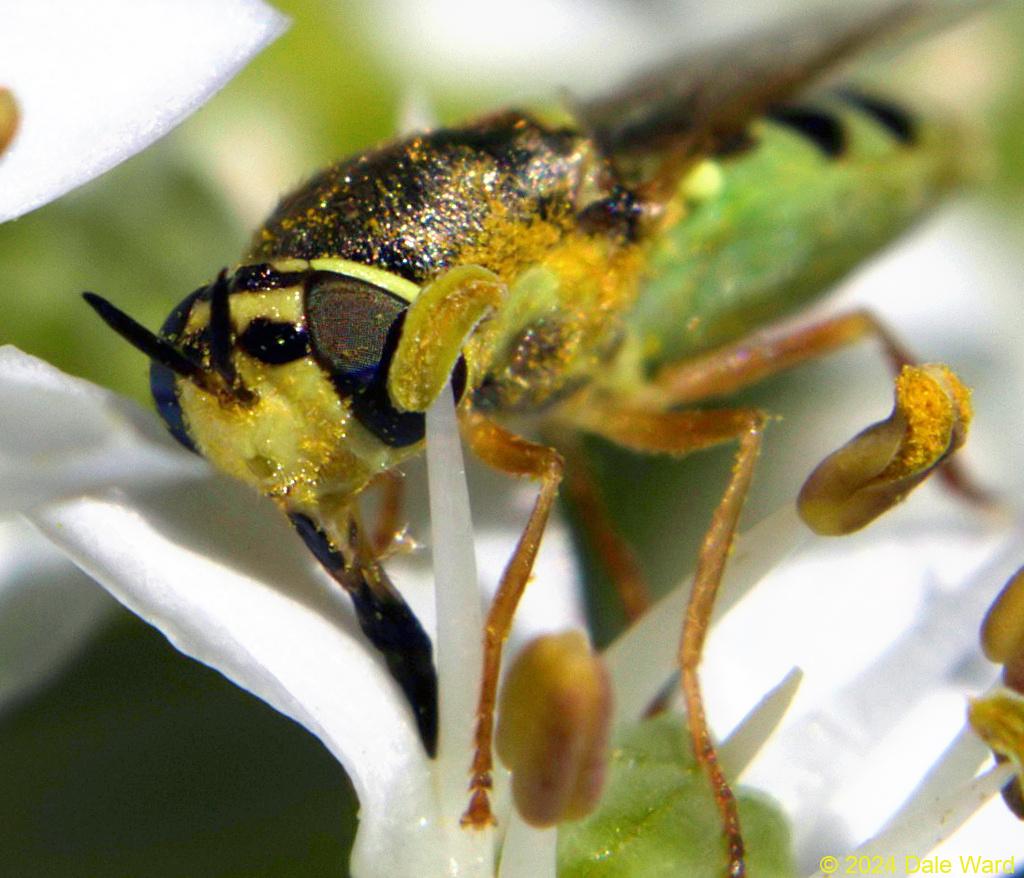 Closer view of a Green Soldier Fly on a Wild Onion flower. This one has its tongue extended, and is lapping nectar from the base of a flower petal. There are pollen grains stuck to the sides of the fly’s thorax and its face. The flower stamens on the right of the photo are just opening up, you can see the partially-exposed pollen. The one that is rubbing against the fly has deposited most of its pollen already, possibly on this fly.
Closer view of a Green Soldier Fly on a Wild Onion flower. This one has its tongue extended, and is lapping nectar from the base of a flower petal. There are pollen grains stuck to the sides of the fly’s thorax and its face. The flower stamens on the right of the photo are just opening up, you can see the partially-exposed pollen. The one that is rubbing against the fly has deposited most of its pollen already, possibly on this fly.
It was interesting to look at the variation in the ‘ripeness’ of different flower stamens. Some of the stamens seemed flat and empty, presumably having already dispensed their pollen onto visiting insects. Others were just starting to slowly open, exposing their pollen gradually, like a banana that is slowly unpeeling itself. And some of the stamens were almost fluffy with bright yellow pollen, such as the stamen in the upper right of the photo below.
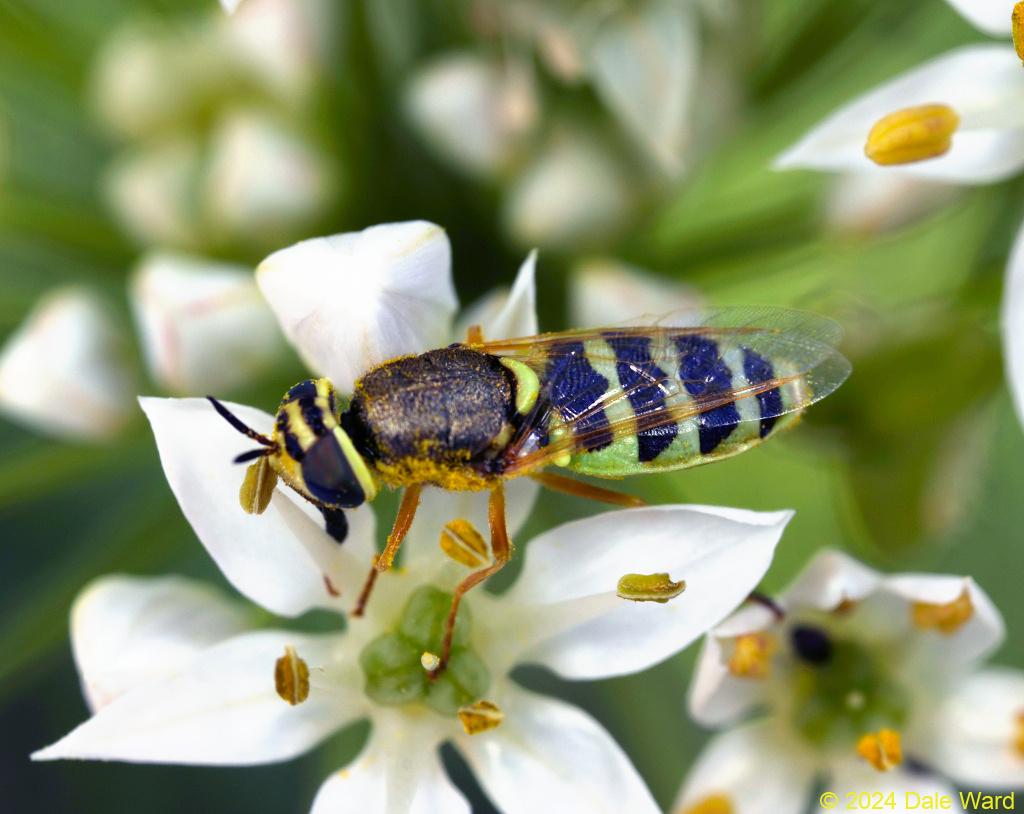 Green Soldier Fly on a Wild Onion flower. This one is lapping nectar from the base of a flower petal. You can see pollen from the stamens stuck to the sides of the fly’s thorax.
Green Soldier Fly on a Wild Onion flower. This one is lapping nectar from the base of a flower petal. You can see pollen from the stamens stuck to the sides of the fly’s thorax.
Sitting out in the garden with my camera, listening to the buzzing of the insects all around, it’s hard to imagine a more fun way to spend Summer afternoons.
As I write this, it’s Wintertime. I’m still looking at the photos, remembering the warmth and the life in the garden.
Notes on Identification - or “w_hy it took me so long to write this blog post_”
I was able to identify these flies to their taxonomic family fairly easily. They’re in the Stratiomyidae - the “Soldier Flies”. Further, they are in the Stratiomyinae subfamily, and the Stratiomyini tribe of the Stratiomyidae.
Getting beyond that, though….well…there I ran into some difficulties. There are estimated to be about 470 species in the tribe Statiomyini, spread amongst 26 genera. And, come to find out, quite a number of these are genera contain black-and-green patterned species. With differences that are, at best, fairly subtle.
So identifying the flies by just leafing through photos on web pages, looking for vague resemblances might be a good start, but probably won’t do the trick. And that’s assuming that the photos one finds online were identified correctly.
In the case of these flies, there are (at least) three candidate genera whose members looked, to my eye, remarkably similar - Odontomyia, Psellidotus, and Hedriodiscus. Each of these genera contains a number of species. So, how to fully identify the fly?
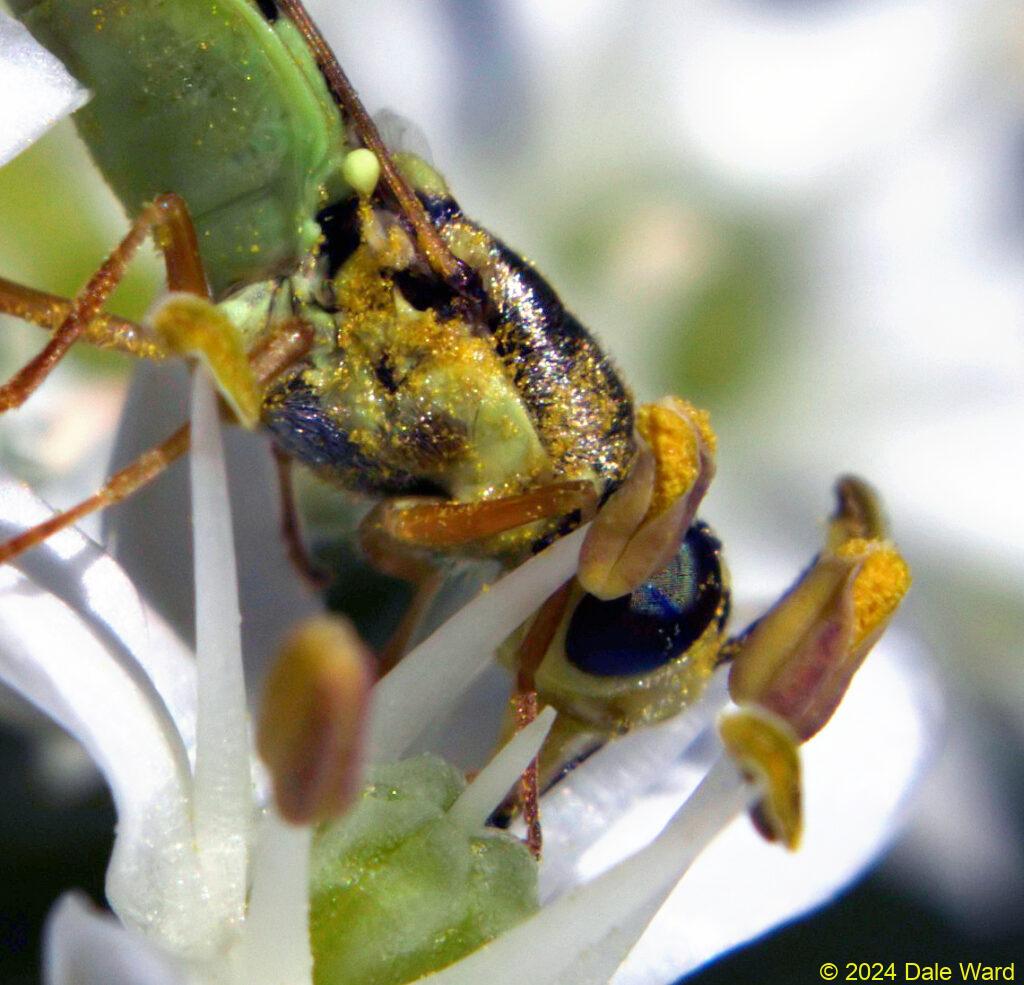 Closer view of a Green Soldier Fly on a Wild Onion flower. The fly’s thorax, face, legs and abdomen all have pollen grains on them.
Closer view of a Green Soldier Fly on a Wild Onion flower. The fly’s thorax, face, legs and abdomen all have pollen grains on them.
If you don’t have an expert to ask, your best bet is to use identification keys. But there can be problems with using keys, too.
One problem is that you might not have access to a particular identification key. Some keys are not available online. In many cases, you need to have access to old books, either physically or through scans.
Some keys may be in a scientific journal, but behind a paywall and therefore inaccessible to you.
Assuming that identification keys for your target insect do indeed exist, and that you have access - you’ve then got to know which of those keys to use. You don’t want to use an older key with invalid species or genera in it. And you don’t want one that is based upon unreliable physical characters that aren’t good discriminators between the taxa.
It’s also possible that the insect you’ve photographed is undescribed by taxonomists - the insect just hasn’t been included in the keys. It’s tough to know whether the difficulties you have with identifying an insect are that the insect is not in the key, or if you have just made a mistake somewhere in traversing the key.
To complicate things, it’s often difficult to identify insects to species based solely on photographs, especially “in the field” photographs of live insects. There’s a great chance that you won’t have exactly the right shot, at the correct angle, of the group of anatomical structure that you need. Getting an image that allows you to count antennal segments, for example, or the exact shape of the last segments of the antennae, can be tough.
As you photograph, you will find yourself wondering - Will the insect hold still for any photo at all? Can you get closer, or change the angle of the camera? Or will the insect spook if you move? Do you even know what identifying features you need to get in the photo?
And then there are the aesthetic questions…Is this a good photograph, one that people would ever want to look at?
How many people, for example, enjoy looking at photos of a fly’s butt?
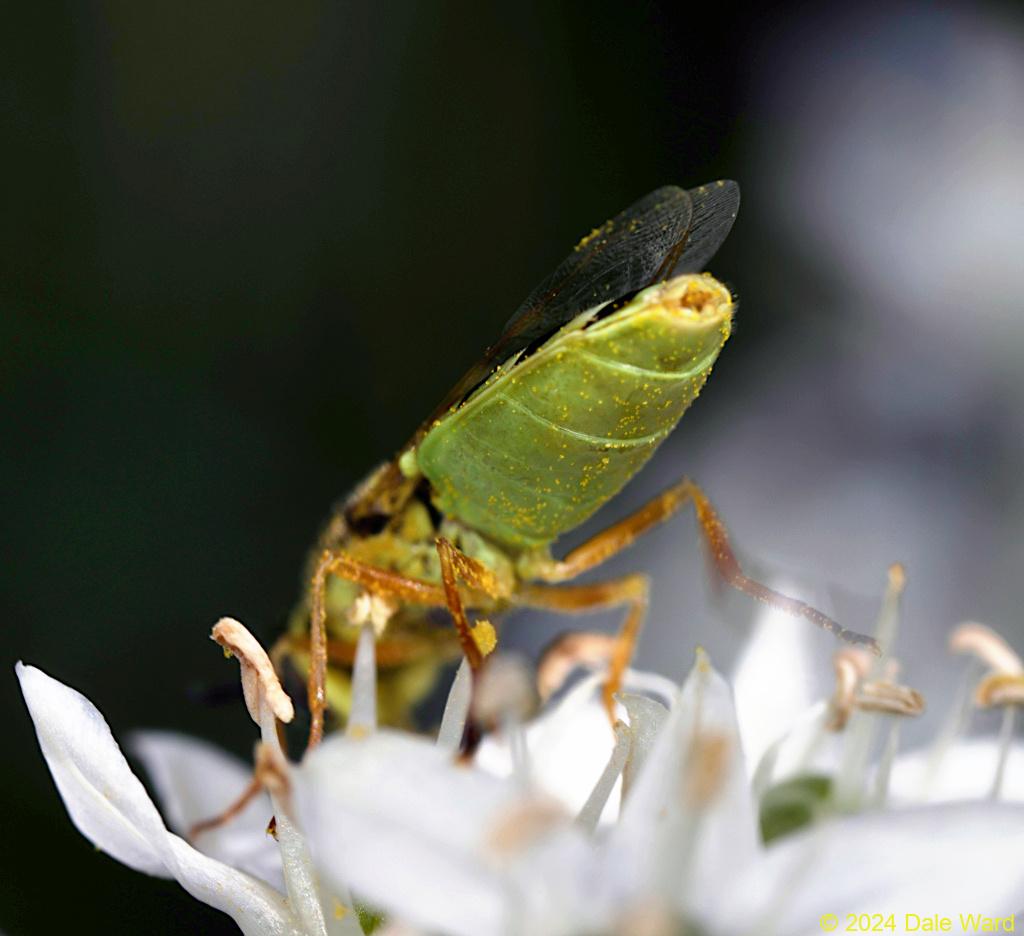 Three-quarter ventral view of a Green Solder Fly (_Hedriodiscus sp_.) drinking nectar from a Wild Garlic flower. You can see pollen grains adhering the the fly’s abdomen and wings.
Three-quarter ventral view of a Green Solder Fly (_Hedriodiscus sp_.) drinking nectar from a Wild Garlic flower. You can see pollen grains adhering the the fly’s abdomen and wings.
And yet, that might be the shot that you need to identify the creature.
All of this leads me to an uncomfortable thought, one which is difficult for me to admit:
For me, at least, having a good photograph - one which displays all of the details necessary for identification - is often a matter of dumb luck.
I may increase my odds of success by having done research beforehand, and so having some idea of what features to shoot. Or by taking lots of shots from as many angles of the insect as I can get.
But still, at the end of the day…far more luck than I’m comfortable with.
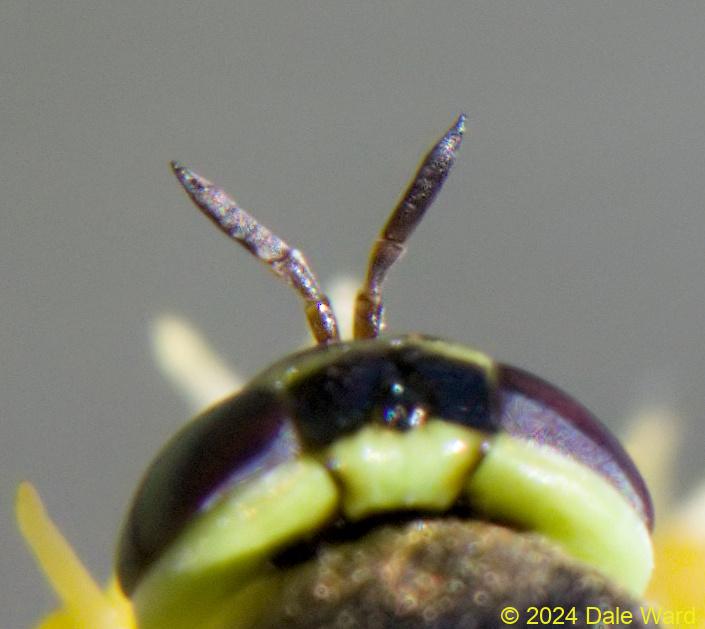 Closer view of the antennae. View is from behind and above the fly, looking forward. Flies tentatively identified as _Hedriodiscus sp_.
Closer view of the antennae. View is from behind and above the fly, looking forward. Flies tentatively identified as _Hedriodiscus sp_.
But wait! There’s yet another problem. Let’s say that you have identified an insect correctly. You take a myriad of photos of that species.
Great! Now you’re all set! Right?
Mmmm…maybe not. You might have identified the particular insect in one of your photos correctly, but should you assume that you can then apply that same identification to all of the similar insects in your photos? What if not all of your photos were taken at the same time and place?
For example, in June many of my Hedriodiscus flies had a thorax with two green dots on it, like this:
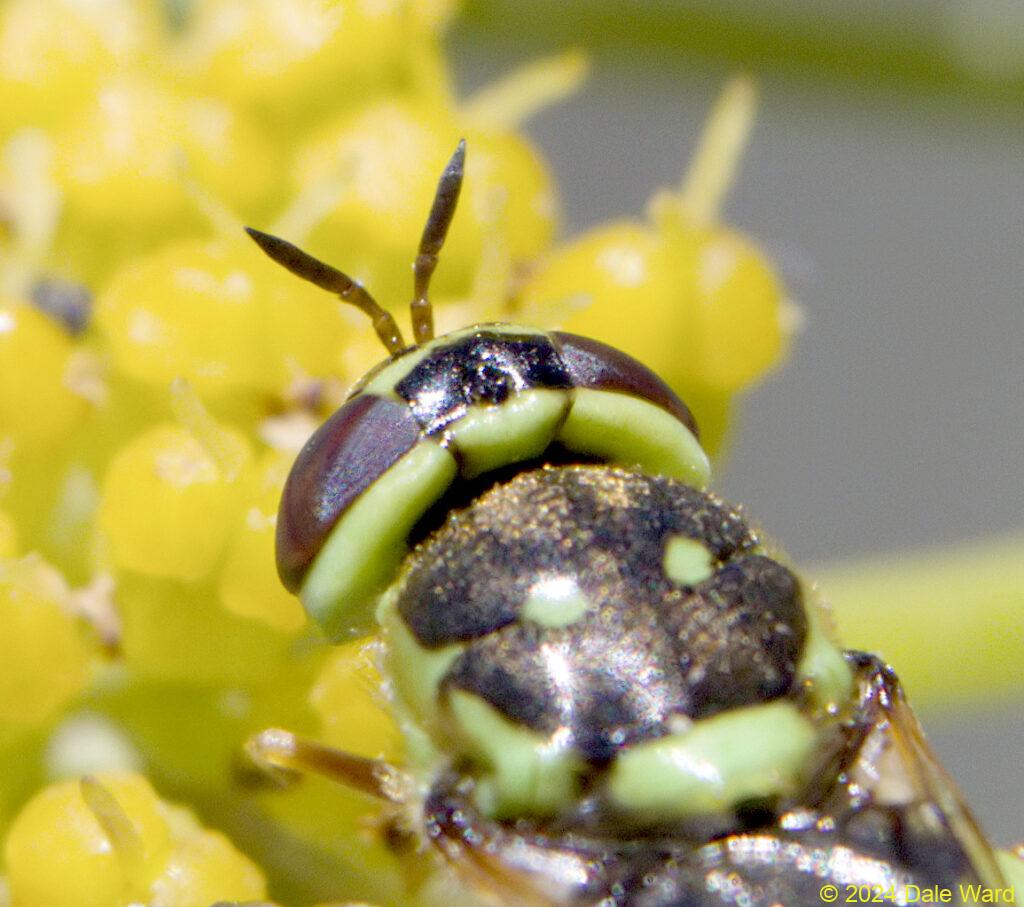 Green Soldier Fly (_Hedriodiscus sp._) on a parsely flower. View of the back of its head, and the antennae. You can see the ‘green dots’ on the thorax in this photo.
Green Soldier Fly (_Hedriodiscus sp._) on a parsely flower. View of the back of its head, and the antennae. You can see the ‘green dots’ on the thorax in this photo.
Then in August, I noticed that many of the Hedriodiscus photos I was taking didn’t have the green dots. The thorax also might appear to be more hairy in the August pictures.
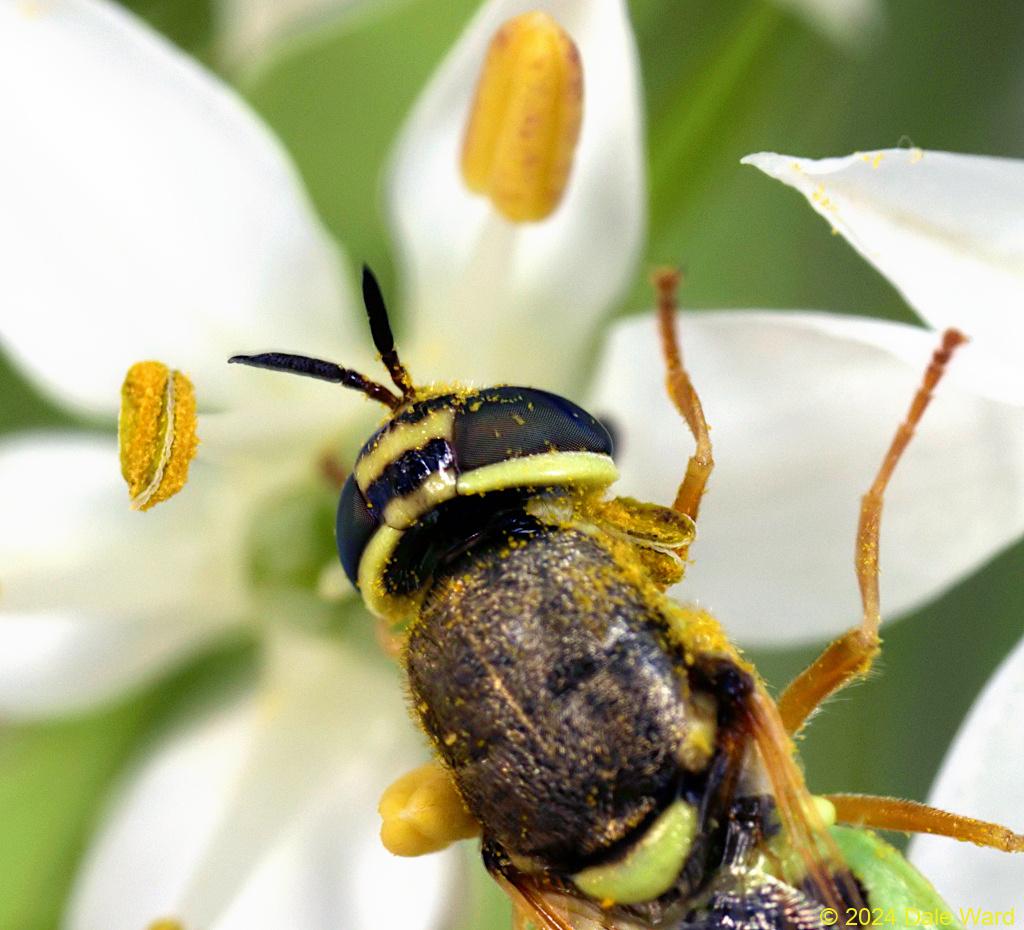 Closer view of a Green Soldier Fly (_Hedriodiscus sp_) drinking nectar from a Wild Onion flower. The fly is putting its body between two of the flower’s stamens, which are dispensing pollen onto the fly. Note the lack of ‘green dots’ on the thorax!
Closer view of a Green Soldier Fly (_Hedriodiscus sp_) drinking nectar from a Wild Onion flower. The fly is putting its body between two of the flower’s stamens, which are dispensing pollen onto the fly. Note the lack of ‘green dots’ on the thorax!
Are those differences in the thoracic markings significant? Are these different taxonomic groups?
I’ve previously mentioned that not all of the flies had the tiny thoracic spines. That spine-variability was within the “two green dots” and “no green dots” flies. So…does that likely indicate one, two, three, four, or even more separate species?
Or is that presence of spines, the patterning of colors on the thorax, etc, just natural variability within a single species?
And would different species necessarily have any consistent differences that are visible to the human eye? In other words, could there be multiple cryptic species within a group of flies, flies that look absolutely identical to humans? Yes, most definitely.
So…when I say that these flies are “Hedriodiscus sp.” (“some species in the Hedriodiscus genus), that’s my best identification.
Identification is hard! So why identify?
It took me a long time to identify these flies, and I’m still not completely certain of the identifications. But without the time and effort I’ve put into identifying them, putting labels on them, I’d not have spent nearly as much time really looking at the images. I would know a whole lot less about Stratiomyid flies in general, and I’d have missed reading a ton of fascinating articles.
Now, I at least recognize them as a group, and I’ll certainly be paying more attention to them as I go forward through the world.
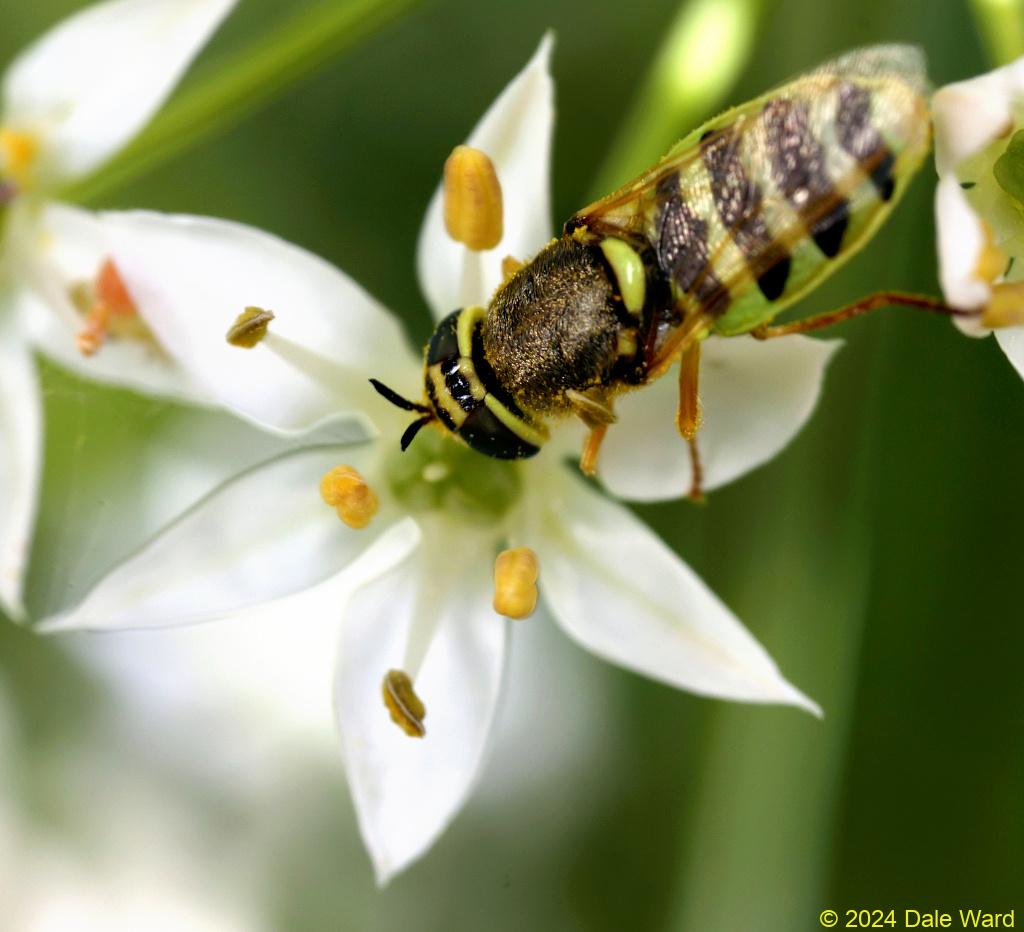 Green Solder Fly (_Hedriodiscus sp._) drinking nectar from a Wild Oniion flower.
Green Solder Fly (_Hedriodiscus sp._) drinking nectar from a Wild Oniion flower.
I guess that for amateurs such as myself, the identification process can be a little bit like a zen koan, a question or sentence that acts as a focal point for practicing meditation.
The koan may not have an answer, and it might not even make any logical sense.
But the answer is not the point.
For my purposes, it’s the process of trying to identify that is the important thing, not the answer. The process requires that I try as hard as I can to get the correct identification insofar as that is possible. But it’s the trying in which I find the greatest satisfaction.
I find that the more I watch the world, the more there is to see.
The more I see, the more I value and enjoy.
And now I’ve got my taxonomic koan on which to meditate, to help me in my strange, strange practice.
Sources
James, M.T., & Steyskal, G. C. 1952. A Review of the Nearctic Stratiomyini (Diptera, Stratiomyidae). Annals of the Entomological Society of America, 45(3), 385–412. doi:10.1093/aesa/45.3.385
James, M.T. 1960. The Soldier Flies or Stratiomyidae of California. University of California Press. This key has some extremely helpful comparative diagrams, especially of the antennae. PDF available here, the missing figures may be found here. Many thanks to Bugguide.net link page for finding and maintaining these link to these references.
Marshall, Stephen A. 2012. Flies: The Natural History and Diversity of Diptera. Firefly Books; 1st ed. August 30, 2012. 616 pages. ISBN 1770851003.
Woodley, Norman E. 2001. A World Catalog of the Stratiomyidae (Insecta: Diptera). The International Journal of the North American Dipterists’ Society. Vol. 11. Ed. F. Christian Thompson. Downloadable PDF here (requires ResearchGate.net registration).
Macroinvertebrates.org has a good page on Odontomyia and Hedriodiscus larvae and their habitats.
Facebook’s Diptera group, specifically David Slaughter for his help in identifying the fly.
And as always - Bugguide.net’s entries have proven to be invaluable. What a stunningly useful resource they are. I’ve used their list of references very heavily, check their site for more up-to-date links to downloadale reference materials.